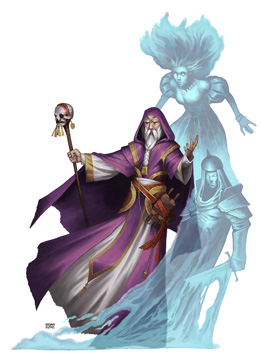
A deeper, vested interest in the campaign, combined with the parity of responsibility for driving the story, often lead duet games to a wonderful, if a little scary, desire: to turn the table around and have the player take on the noble task of GM, while the GM plays a GMPC or other NPC from the campaign. Turning the table around gives everyone a new perspective on the shared world. The GM gets to move from a sort of third-person omniscient perspective to first person while the player experiences the reverse.
Our last post extolled the many benefits of playing with one player and one GM (also known as a “duet”) that make this option hyper-attractive and contribute to the growing numbers of dungeon-delvers. Some of these boons include the ease of finding time to play, the freedom to pursue your gameplay preferences, and the great fun of co-creation.
Without the spotlight constantly shifting to focus on a different party member in large group games, both the GM and the player in a duet have a little more work to do. The GM must be ready for more to happen over the course of a session since the party won’t waste half the game arguing about what to do next. But the player especially must be ready to provide some of the story beats that might traditionally rest in the GM’s wheelhouse. For this reason, duet players tend to be more committed and involved in the game, which leads to a depth and richness I’ve not seen in large group games. With two, everyone at the table has more stake in making sure that things are fun and interesting. This is why swapping roles at the table is worth the leap of faith.
Turning the Table
In a duet game, the lines between who oversees setting up and running the events of the world and who is running around in that world can get a little blurry. We’ve talked before about the wonders of co-creation and GMs who lead with “yes, and.” Turning the table around is taking the “yes, and” concept and pouring gasoline on it!
The player (as GM) gets to weave their own story in a world that they helped create while the GM (as a player) enjoys the sheer pleasure of running around and interacting with a story without the weight of the imagined world on their shoulders. Everyone wins.
Turning the table around might seem terrifying to some GMs. It does mean a potentially uncomfortable loss of direct control over the world and narrative. Allowing someone to control a thing that has so much work put into it is an act of trust. Trust can be nerve-wracking, but the benefits make the risk well worth it.
The mantle of responsibility for running the world is definitely scary for the player-turned-GM as well. Because players know the effort that went into the co-created story space, it can feel extra dangerous or like they are going to mess things up. Sitting at the helm, though, provides a magnificent opportunity for the player to more deeply explore an element of the world that interests them.
When to Turn the Table
It will lead to some confusion if every time a duet sits down for a game there’s a coin flip to see who is in charge. There are some opportunities, though, that lend themselves to a natural turn of the table. Duets might consider switching things around, for instance, at the conclusion of a major story arc. Usually parties have a bit of downtime in between while the next threads come together. Or for an ultra-low-stakes turn, a GM might allow a player to run a dream sequence that incorporates a GMPC or secondary NPC backstory and enriches their characterization. That richness will carry over into the “normal” game and make that character all the more believable and interesting. On the opposite end of the “stakes spectrum,” the player could GM for a character navigating the afterlife and trying to return after a disastrous combat encounter in which the PC prevailed but a beloved companion did not.
Essentially, whenever there is a break from the regular pace of your duet game, it is an opportunity to turn the table around. If one of these breaks pops up and everyone is into the idea, seize the moment!
How to Turn the Table
It is important to set up the turned table for success. Have a conversation about expectations for the arrangement and about what elements of the world both parties might be interested in exploring. Consider what character the GM might be playing. Will it be a GMPC with which the player probably has an intimate familiarity? Or perhaps a tertiary character that has promise enough to enrich? Depending on the length and scope of the switch, the GM may need to ask that a few elements of the world or important NPCs be off-limits if they already have plans. This comes with a small caveat, and I encourage GMs to be brave and to trust the player. Beyond just saying that they can do what they like with their session, communicate as much with equal measures of care, consistency, and enthusiasm. It’s the player’s world as much as it is the GM’s.
As ever, the key to a positive experience at the table is communication.
The More the Merrier
One of the best things that GMs will have accomplished by turning the tables on the player is to have given them the experience of GMing. If you’ve been around TTRPGs for any length of time, you’ll have noticed that it is rare to have too many people ready to run the game and not enough around to play. Making new GMs is always good. And the best GM yet might be the player sitting across the table from you.
___
You can find more advice and ideas for one-on-one play at dndduet.com.
